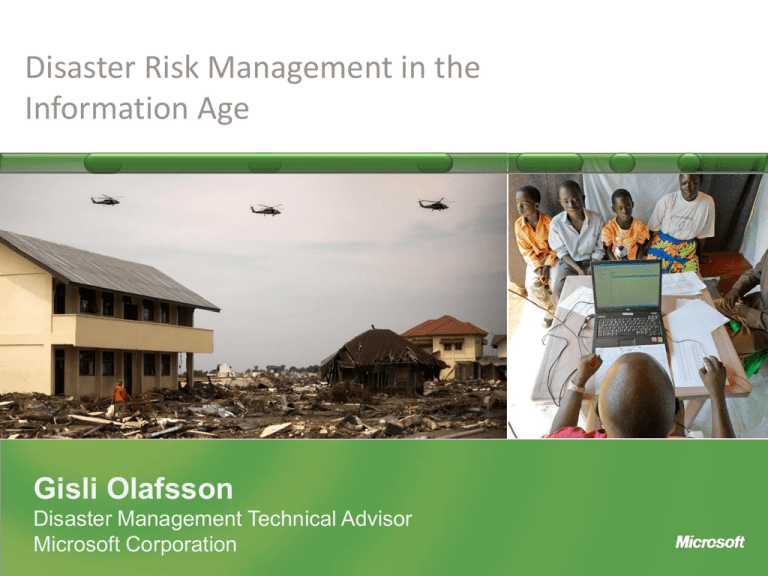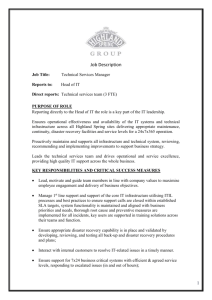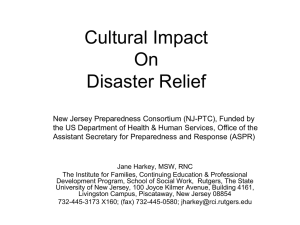
Disaster Risk Management in the
Information Age
Gisli Olafsson
Disaster Management Technical Advisor
Microsoft Corporation
Disaster Risk Management in the Information Age
Crisis & Disaster Stakeholders
Responders
First Responders, Fire, Police EMT
Secondary Responders, National Guard, Emergency Management Authority &
FEMA
Nations
Public Health
National Governments, Intelligence,
Health and Human Services, and Medical Centers
Security and Defense Agencies
Inter Governmental Organizations
United Nations, NATO, EU
Critical Infrastructure
Constituents
Transportation, Banking, Public Works &
Utilities
Requirements:
Coordinate and host
diverse agencies
Alert and inform
Share common operating
picture
Manage supply chains
Non Governmental Organizations
Red Cross, NetHope, World Cares
Citizens
Individuals in the broad population
Private Enterprise
Top Multi-national corporations
Leadership
Heads of schools, cities, states,
countries
Challenges
Lack of common
operational picture
Difficult to
disseminate
information quickly
Impedes efficient
response
Mapping/topography
identification
Interagency
coordination
Outdated, slow, and
paper-based
Challenges &
Requirements
Technology
Transforms
Microsoft Product
Platform
Success Stories
Partner Offerings
Collaboration during disaster
Coordinated chaos?
UNDAC
Affected
Population OSSOC
Affected
Government
Donor
Govt’s
ICRC
NMCC
UNDP
HCR
UNICEF
National
military
USAID/
DART
WFP
IFRC
Private
Humanitarian
Coordinator
EU
MEDIA
CIMIC
MIL
OCHA
Geneva
PNSs
NGOs
Ambassadors
NGOs
IGOs
Focus Area
“International, regional and national organizations should work better together and be better
coordinated.”
10 lessons learned from the South Asia tsunami of 26 December 2004
Retrieved February, 2008, from Relief Web:
http://www.reliefweb.int/rw/rwb.nsf/AllDocsByUNID/c070ab378bd25f4585256f82005d0d70
Assist in preparedness by allowing
processes to be established and
easily followed
Assist in response by allowing
information to be disseminated to
various involved parties in a timely
and efficient manner
Wattegama, C. (2007). ICT for Disaster Management. Retrieved February, 2008, from Asia
Pacific Development Information Programme
Assist in recovery by ensuring
schedules tasks are tracked and
monitored
Disaster Risk Management in the Information Age
Microsoft’s Strategy & Approach
ICT Private Sector Role
in Disaster Preparedness
Preparedness is the enabler for
cooperation throughout the
Crisis Management Lifecycle
Policy Influence
Preparedness
Relationship Management
Program Offerings
Incident
Management
Recovery
Crisis
Management
Lifecycle
Relief
Response
When to Deploy New Technology
Technology
Everyday
Disaster day
Microsoft® Disaster Preparedness
Program unities
Preparedness
Collaborate
Train
Assess
Provide “Community
of Practice”
environment to,
further
understanding,
consensus &
address issues
Demonstrate Virtual
Disaster Response
Simulation that
may enhance
organizational
capability & enable
more informed ICT
adoption
Enable Threat
Analysis, Risk
Mitigation &
Dependency
Identification
MOSS
ESP, SQL, VE
SDL, TAMe
Offerings founded upon Microsoft core competencies
Disaster Risk Management in the Information Age
Success stories:
Information Sharing & Collaboration
UN OCHA Collaboration
Myanmar Humanitarian Information Centre (HIC)
http://myanmar.humanitarianinfo.org/
Rapid response made possible through preparedness work
Relationships established, portal requirements and blue print
developed in March 2008 in advance
Execution made possible through our partners
•
•
•
•
•
•
•
12
Burntsand
Compellent
CorasWorks
Coroware
e-Sponder
IDV Solutions
L-Soft
•
•
•
•
•
•
MindTree
Neudesic
Sun
TM
Weather Central
Weather Decision Technologies
13
Disaster Risk Management in the Information Age
Success Stories:
Learning & Training
Experiential Learning:
Disaster Simulation Learning Architecture
How We Simulate The World
DEM/DTED
Space Shuttle
NED
Facilities Data
Jeppesen Charts
NOAA hazards
DAFIF
Land Class
Tiling textures
Satellite imagery
Vehicle
Simulation
Trains, aircraft, boats,
etc
Single person and
multi-user operable
Vector Data
Roads, power lines
Coastlines, rivers,
lakes
Characters
Age
Ethnicity
Ambient population
World
Time and seasons
Weather
Celestial sphere
A.I. Paths
Car traffic
Aircraft traffic
Ship traffic
Cultural
Objects
Unique Objects
Triggers
After Action
Review
Trees and vegetation
Generic buildings and
objects
Scenario creation
Missions
Events
Area specific
Landmark objects
Analysis
Tracking
Rewards
17
Interactive Development Approach*
Training Simulation Prototype
Specific Scenarios
Scenarios
Case
Study
Development
of case-based
training
simulation
Model must
provide for
Decision
Model
Interactive approach
Team-orientation
Role-playing experience
Empirical Data
Learning Objectives
*Based on: A.P. Moore et al., IEEE Security & Privacy, Education, Volume 6, Number 1, January/February 2008
© 2008 Microsoft Corporation. All rights reserved. Microsoft, Windows, Windows Vista and other product names are or may be registered trademarks and/or trademarks in the U.S. and/or other countries.
The information herein is for informational purposes only and represents the current view of Microsoft Corporation as of the date of this presentation. Because Microsoft must respond to changing market conditions, it
should not be interpreted to be a commitment on the part of Microsoft, and Microsoft cannot guarantee the accuracy of any information provided after the date of this presentation.
MICROSOFT MAKES NO WARRANTIES, EXPRESS, IMPLIED OR STATUTORY, AS TO THE INFORMATION IN THIS PRESENTATION.










